The Hidden Middle Class
Picture a Venezuelan middle class family. What image comes into your head?If you're like most people, you're thinking of the Mavesa family. You know, the one in the commercial. Husband comes home, tie loosened on the car ride home from the office, to meet his dashing young wife in their beautiful Caracas apartment. Bima furniture. Cocina empotrada. Cell phones. Mayonnaise. That sort of thing.
We all know what that middle class is about. The Venezuelan dream. It's an image. A set of associations. A lifestyle. It hardly needs much elaboration. We all know what we're talking about when we say "middle class." Don't we?
Well...don't we?
But what if...what if that image distorts as much as it reveals? What if the associations we've built up around it blur out whole groups of people who, on closer scrutiny, should be seen as middle class?
What is this Mavesa family like, anyway? For one, they live in the city. Almost certainly in Caracas. In the Mavesa scheme of things, there is no such thing as a rural middle class. What's more, the Mavesa middle class is professional. It has a university degree. It's made up of managers, lawyers, doctors, architects, engineers. It wears a tie to work every day, and depends on its salary. Most pointedly, the Mavesa middle class has money. Not too much money, granted - we are not talking about the rich here - but certainly more than the vast majority of people in Venezuela. All those nice kitchens and cars and cell phones, those are expensive. Having the money to buy these things has become a marker of middle classness.
In day-to-day speech in Venezuela, then, middle class has become more an income category than an occupational grouping. Roughly, when you say middle class what you mean is "not rich, but certainly better off than most." This image of the urban, professional, educated, employed, relatively well off middle class is so ingrained in public discourse in Venezuela it's difficult for people to see beyond it. It takes a bit of sociology to realize just how badly the Mavesa image distorts our understanding of who is and who is not middle class.
What you do, not what you earn
To start to see the problems with the Mavesa image of the middle class, you have to stop thinking just about income and focus instead on people's relationship with the world of work.
For Marx, your class affiliation has nothing whatsoever to do with income; it has everything to do with your relationship to the world of work. Those who own the inputs that generate wealth are capitalists, those who make a living by selling their work to the capitalists are proletarians. That's that. By this reckoning, of course, the Mavesa middle class is not actually middle class at all: that flawlessly groomed husband sells his labor to an employer. For Marx, at least, he is merely a privileged member of the working class.
The problem is that this kind of understanding leaves no space at all for the middle class as such, as a class distinct from both owners and workers. Seen in this way, what we think of as "middle class" is merely a group of particularly privileged proletarians or particularly pela-bola capitalists. Marxists have always presumed that these people "in the middle" would eventually have to choose sides between the two dominant classes. In fact, Marxist sociology tends to erase the middle class from the picture altogether. Marx presumed that the conflict between capitalists and proletarians would be the driving motor of history, so why waste time examining the position of the residuals in the middle?
Marx did recognize the existence in Europe of a large number of people that occupied a somewhat paradoxical position between capitalists and proletarians. These were the armies of small time shop-owners and small-fry manufacturers working in the tiny workshops that proliferated in 19th century Europe. The por-su-cuenta squad.
Marx thought of these people basically as capitalists. They certainly own the means of production they use, and since this was the key litmus test for Marx, he labeled this group the "petty bourgeoisie", the small-time capitalists.
But thinking of this strata as being "just like" regular capitalists, just on a smaller scale, misses the particularity of their position. The day-to-day reality of working life for very small-scale producers and traders often has more in common with the day-to-day life of the traditional working-class than with that of capitalists. They may own the means of production they use, but they basically work for a living. Unlike capitalists, they can't rely on their capital to keep them fed. Unlike workers, they have no access to a steady quince-y-ultimo salary, or collective bargaining, or statutory vacation pay. Their position, if anything, is more precarious than that of the organized working class: if they work, they earn; if they don't, they don't. They are not small-time capitalists as much as they are owner-workers.
Now, it won't have escaped an alert reader that this group that Marx described as the petty bourgeoisie corresponds, in contemporary Venezuelan terms, to the informal sector. An owner-worker class does indeed exist in Venezuela, and a big one...it's just that, in Venezuela, this part of society earns its living beyond the scope of the law.
Here we begin to see why the Mavesa family image is such a lousy reference point when you're trying to picture the Venezuelan middle class. Because Venezuela's current petty-bourgeoisie, Venezuela's genuine occupational middle class, has almost nothing in common with the Mavesa family. It is a nation of buhoneros. Of mata-tigres. Of taxi-drivers and conuqueros. Of people who can't get proper jobs, but they own a tiny little bit of capital, and they try their best to make a living out of it.
That middle class, that occupational middle class, has always lived beyond the reach of the state. It shares none of the characteristics of the Mavesa family. It is more likely to come home with a gunshot wound the neighborhood tough than it is to come home smiling from a nice air-conditioned day at the office.
Venezuela's informal economy - its real middle class - is huge. Since 1994 has made up roughly half the country's work force. It is by no means solidly urban. It counts as members hundreds of thousands of small-scale farmers, as well as owner-workers in small-scale agricultural input and processing activities in the countryside. It far from professional. Informal economy workers are, statistically, less educated than formal sector workers. And its members are certainly not relatively well-off: according to a 2002 UCAB Poverty Project study, 9 out of 10 informal sector workers earn less than the legal minimum wage.
When you start to think of the informal economy as the hidden middle class, you're hit by the startling realization that Venezuela's occupational middle class - its owner-workers - has long been worse off than its working class. The post-1958 political system, with its corporatist emphasis on balancing the demands of capitalists and workers, systematically excluded the ranks of the owner-workers from political power.
This structural exclusion is made dramatically visible in the composition of the old tripartite commissions that, before Chavez, were charged with negotiating wage policy. The system formally included capitalists (Fedecamaras) and workers (CTV) in wage-bargaining, but did not even recognize the existence of a sprawling universe of small scale owner-workers. The por-su-cuentas had no seat at the table. The fourth republic had no structures for including or empowering the hidden middle class. In the end, it was the small-scale owner-workers' anger at their marginalization that propelled Hugo Chavez into power.
From this perspective, the 2001-2004 alliance of CTV and Fedecamaras against the government played perfectly into Chavez's game plan. Relying on exploiting the sense of resentment of the excluded against the included, Chavez had no trouble painting CTV and Fedecamaras as the Enemy. His main constituents - who had always been shut out of the legal economy and therefore had no personal stake in the outcome of tripartite commission negotiations - applauded his refusal to deal with either of the two bodies.
The weirdly counterintuitive conclusion, if such a reading is correct, is that what Chavez is leading is a revolution of the middle class. It sounds strange to put it that way because the images we associate with middle classness are based on images based on income rather than occupation. Whatever sociological theory says, most of us will always have a hard time looking at a buhonero or a conuquero and thinking of them as archetypes of middle classness. In income terms, buhoneros and conuqueros are among the poorest people in Venezuela, what's "middle" about that?
What's middle about it is the dual nature of owner-workers' relationship to capital and work. Those who live off their capital and do not work are capitalists, those who live off their work and have no capital are workers, and those who both own their capital and work to make a living are, well, in the middle.
The hidden middle class and the East Asian Economic Miracle
This whole stream of unorthodox thoughts occurred to me while reading "Discipline and Development : Middle Classes and Prosperity in East Asia and Latin America", the startlingly lucid new book by MIT historical sociologist Diane Davis. The book's starting point is one of the hottest debates in development economics today: why have East Asian economies outperformed Latin American economies so decisively over the last fifty years.
To make sense of Davis' thinking, you need to take a little side-trip into the history of the East Asian economic miracle. Davis focuses on just two countries: South Korea and Taiwan.
In the four decades after 1960, the South Korean and Taiwanese economies grew faster than any economy ever in the history of the world. In forty years, these countries went from having the per capita income of today's Haiti to having the per capita income of today's Spain. This success brought them more than a little bit of attention from development economists. What they found made uncomfortable reading for many of them.
Even the most superficial look at the economies of South Korea and Taiwan showed major differences with the standard, "Washington Consensus" style recipe for development. Though many US trained economists saw liberalism as a kind of divinely ordained absolute good, it didn't take long to realize South Korea and Taiwan had in no way given free rein to the "invisible hand" of the market during their economic take-off years. Instead, they relied on peculiar combinations of private enterprise and public planning. Industrial production was in the hands of capitalists, certainly, but industrial financing was controlled by state-owned banks. Foreign direct investment was essentially banned in South Korea until the late 1980s. Technology transfer provisions were prominent, and the state had a clear strategy to help local companies crack into particular export markets.
The industrial development vision was based on exporting manufactures for the world market, certainly, but companies were often pushed to participate in the export drive by government fiat. In some cases, the government literally forced companies to enter particular export markets by threatening to withold financing if they did not. Governments made special efforts to help private companies produce for the export market, rewarding successful exporters with further directed credit and subsidies while punishing unsuccessful exporters by witholding such facilities. Companies that could not compete in export markets were simply allowed to fail.
South Korea and Taiwan, then, relied on a highly peculiar combination of private and public institutions to achieve their development gains. They did not, as the Washington Consensus crowd might have wished, minimize government intervention in the economy. Just the opposite. South Korean and Taiwanese bureaucrats identified the most promising industrial markets for export growth, coordinated the financing and know-how for local companies to enter those markets, they administed financial resources to foster them and systematically sought to reward capitalists who acted in accordance with their development priorities while punishing those who did not. Both civil servants and businessmen in East Asia have always understood and accepted that it is the public sector that is in the development driver's seat, with capitalists acting within the narrow bounds allowed to them by the state's development policy.
Autonomous states?
A very big literature now exists on how exactly these East Asian states managed to launch their countries on the path to self-sustaining economic growth. Scholars like Linsu Kim, Alice Amsden, Robert Wade, Chalmers Johnson and Margaret Woo Cummings are among the most prominent in this field. The policy-mix the East Asians used has been labeled "state-led, export-oriented development," and the type of state able to pull off this kind of policy has been described as the "developmental state."
Studies of the developmental state have traditionally stressed "state autonomy" as the key to the success of the east asian development model. Following Berkeley sociologist Peter Evans, they've highlighted the East Asian state's ample authority, its space to act autonomously of pressures brought to bear by various social groups.
It's not hard to see why such autonomy from vested interests is important. In Latin America, where states have been much less autonomous from social pressures, efforts at state-led industrialization have generally morphed into giant corruption rackets. States beholden to the interests of capitalists seek to accommodate their clients: a state that cannot act autonomously of capitalists is most unlikely to work to discipline them.
Instead, capitalists' work to use their privileged access to the state to get their hands on state resources. Venezuela's post 1973 history is one long case-study of this dynamic. Similarly, states beholden to the narrow interests of workers lack the autonomy to discipline the working class's wage demands. Peru and Argentina, with their long histories of hyperinflation, are classic examples of the economically catastrophic consequences of continually seeking to accommodate the working class to the detriment of other segments of society.
The suggestion, then, is that the East Asian states had a special ability to discipline rather than accommodate both capitalists and workers, and that's how they managed to resist corruption.
The Middle Class core of the developmental state
It's a this point that Davis' fascinating book picks up the story. The question she wants to ask is not so much how the East Asian Developmental State operates, but rather what the social foundations of such a state might be. What are its key constituencies? What is its "social base"? Who does the government play to? Whose values does it encarnate? And how did those values allow a few countries to turn the remarkable trick of setting up a professional state able to plan and coordinate Export-Oriented Development without becoming hopelessly corrupt?
Davis' answer, you will not be surprised to hear, is all about the middle class. And what she understands by "middle class" is much closer to the informal-economy model of owner-workers than to the Mavesa image that predominates in Venezuela.
Davis questions the very notion of an "autonomous state." States cannot act in a social vacuum, with no organic rooting in the society where they operate. Not even dictatorial states. All states need some form of social base, and the base they choose will, to some degree, determine the kinds of values they embody and the forms of policies they will apply.
In the late 1950s and the early 1960s, she explains, South Korea and Taiwan were overwhelmingly rural countries. Both implemented wide-ranging, successful, US-backed land reform programs aimed at creating a kind of Jefersonian society of small-scale farmers. By the early 1960s, 70% of South Korea's population lived in the countryside, and 90% of farmers were owner-workers. They were South Korea's conuqueros - a class created by land reform, and demographically dominant over the rest of the country. That they were poor - very poor, even - nobody could deny. But they owned the capital they used to make a living, so Davis labels them the rural middle class.
In the pages that follow, Davis traces the hidden history of the relationship between rural owner-workers and export-oriented industrialization. Going directly against the grain of almost all development theorizing on East Asia, she argues that it was the state's decision to privilege rural development over urban development, and rural middle class values over urban capitalist or working class values, that allowed the East Asian states to become autonomous enough from capitalists and workers to discipline them properly. Based on a close reading of the political history of South Korea and Taiwan, she stresses the way both governments saw small-scale rural producers as both a key constituency and a moral reserve for the nation.
At the heart of Davis' contribution is a discussion about values. Much has been made about the supposed role of the protestant ethic and of "Asian Values" to account for the first and last waves of industrialization. Indeed, the values claimed for protestants and Asians in turn are remarkably similar: hard work, thrift, individual responsibility, respect for authority, a high propensity to save rather than consume. For Davis, however, both labels are wrong...the values that Weber pinpointed over a century ago and Lee Kwan Yew highlighted in the last decade are neither uniquely protestant nor especially Asian. What they are, she says, are middle class values, and in particular, rural middle class values.
For Davis, owner-workers, particularly rural owner-workers, tend towards certain values by virtue of their relationship to work. Small-scale farming, in particular, is an occupation that virtually demands self-discipline, hard work, thrift, and forward planning in order to be viable at all. The vicissitudes of the weather and the ever-looming possibility of crop failure makes it imperative to save rather than consume whenever possible. The long lag times between sowing and reaping force small scale farmers to plan ahead. And the sheer botanics of the job demand very long hours of very hard work.
In the Korean case, Davis stresses the life history of Park Chung Hee, the country's military ruler from 1961 through 1979. General Park himself grew up in a small-scale farming household, and remained ideologically committed to the values of the rural middle class throughout his career. His emphasis, once in power, was both to symbolically honor its values and to orient South Korea's development to the service of small farmers. As Davis puts it (p. 83),
"Park initially conceived of industrialization as a means to an end, not an end in itself, and not necessarily as his principal development goal. 'Whatever else we may consider at this moment,' Park proclaimed in 1962, 'the most urgent and fundamental need is that the rural communities should have precedence over everything else. It is the top priority.'"
Unearthing seldom recognized parts of the history of South Korea's breakneck development, Davis shows us how it was this ideological commitment to farmers that kept the government in a strong position vis-ŕ-vis industrialists and workers in the cities. Unlike Latin American leaders, who sought to accommodate capitalists and/or workers by protecting urban industry from imports, General Park's industrialization was all about keeping his rural base happy. Exports were promoted for the purpose of earning foreign exchange to finance rural development plans. Park's export-oriented development strategy was based not on some ideological commitment to urban development, but on the need to export manufactures in order to earn dollars that could be spent on importing agricultural inputs.
Park was in a strong position in relations to urban capitalists and workers precisely because they were NOT its main constituencies. Since his main concern was to accommodate the values and lifestyles of the rural middle class, he could afford to play hardball with urban constituencies, to discipline them rather than accommodate them. And it was this discipline, meted out both to capitalists and workers, that laid the groundwork for the spectacular success of the country's urban development, which would end up completely outstripping the gains made in the countryside.
Unintended industrialization
The story of South Korea's development, then, is paradoxical on several counts. It took a government concerned chiefly with the values and priorities of small farmers to set the stage for the quickest industrialization in human history. The law of unintended consequences is, perhaps, the single biggest driver of Davis' theory. Governments, she suggests, are seldom aware of the ultimate consequences of their actions. The runaway industrialization in East Asia in the 80s and 90s was, from the point of view of the rulers who engineered the development miracle, a kind of accident.
What's important for development, she suggests, is the way the state in South Korea and Taiwan adopted the values of hard-work, forward-planning, fair play and thrift into their ideological DNA. The East Asian state, in this perspective, is not so much "autonomous" as it is embedded in the values of a class that prizes hard work and thrift above all else. This has not often been recognized simply because middle classes have become invisible to development theorists used to a marxian, class-polarized vision of society as a contest between capitalists and workers.
These are dangerous thoughts for a Venezuelan antichavista to harbor. The Chavez government is, in many ways, a middle class embedded regime. And middle class embeddedness seems to be a key ingredient for successful industrialization. Certainly, the Chavez government has dealt harshly with both organized labor and the organized business class. And while export-led development is obviously not Chavez's stated aim, we have already seen that intentions and outcomes can diverge very widely in such settings.
Could it be that, in the most bizarre way imaginable, Chavez has stumbled into something like a Latin Americanized version of the Asian development state?
Frankly, I doubt it. All sorts of studies of the East Asian Miracle specify what is meant by "discipline" in this context. "Disciplining capitalists" does not mean badgering them out of insistence, intimidating them into submission, or persecuting them through the courts. Disciplining capitalists means setting out a clear, stable, predictable set of institutions and incentives designed to allign capitalist's private interests with wider social interests, with a view to attenuating corruption. Similarly, disciplining workers does not mean randomly abusing them, imprisoning their leaders, and declaring their organizations enemies of the state. It means bringing them into a broader framework for development where their own interests are balanced off against those of the nation as a whole.
In short, what Chavez does is not to discipline capitalists and workers, but to brutalize them. His random, arbitrary treatment does little or nothing to allign their incentives with those of society as a whole. More importantly, it's based on a set of values that - although it has been widely adopted by the Venezuelan owner-worker class - stands in sharp contrast with the traditional values of the rural middle class.
And here, Venezuela's peculiar history of owner-worker exclusion and petrostate clientelism plays an important role in explaining the path the country is transiting now. Though the Venezuelan has a huge number of owner-workers, those owner-workers have not learned the same experiences from their day-to-day relationship to work as their South Korean counterparts in the 1960s learned.
Venezuela's recent history of sharp macroeconomic instability brought on by successive oil-market boom-and-bust cycles has weakened owner-workers' perception that their success depends on hard work, discipline and thrift. Instead, the only reasonable lesson an informal worker in Venezuela can draw from his or her work experience is that success depends on the inscrutable workings of the international oil market or, more precisely, on the waves of government spending that come in the wake of sporadic oil booms. Failure is equally beyond the control a Venezuelan owner-workers' success - again and again, oil market busts have led to collapses in demand that overwhelm any efforts to prepare.
Meanwhile, the only exit from this cycle seems to lie in building clientelist relationships with those in power, an old and terrible habit Chavez has not been shy about exploiting.
The bad news for the opposition is that it has alligned itself with organized workers and capitalists against the one class whose values could conceivably serve as a springboard to development. The good news is that the Venezuelan middle class is far bigger than commonly believed. Learn to communicate with them, learn to put them at the center of a development vision and discourse, and the opposition has a nearly limitless pool of potential supporters.
What is to be done?
How, then, do we woo back the owner-worker class and, at the same time, lay the foundations for meaningful development? This is a political question, requiring political vision and political leadership.
The first thing to accept is that, more than anything else, Venezuela's owner-workers crave a government that will show a little backbone when dealing with its capitalists (and to a lesser extent, its organized workers.) They are disgusted by the perception - often justified - that the traditional elite wants to re-take control of the state only in order to go back to accomodating capitalists and organized workers, marginalizing owner-workers once again in the process. In light of the South Korean and Taiwanese experience, this middle class thirst for a government that disciplines capitalists rather than accommodating them is a good thing, not a bad thing.
Unfortunately, much of the opposition's discourse serves to convince this urban middle class that it wants to return to an accommodationist posture if it retakes power. Each time an opposition leader decries Chavez's "scaring away investors" he simply reinforces this perception. Such a discourse will never mobilize the owner-worker class around an alternative vision. And it's a good thing, because chavistas may never have heard of Diane Davis, but their seat-of-the-pants feeling that handing decision-making over to capitalists would be a disaster for the country's development prospects is spot on.
What the opposition needs to do, then, is to re-gain the confidence of Venezuela's hidden middle class, of the group of owner-workers who have always underpinned rapid development experiences. That this key constituency now overwhelmingly supports Chavez is an alarming first realization. But armed with Davis' brilliant critique of East Asian growth, we can suggest some tentative themes for a successful drive to woo the owner-worker class.
First things first: Chavez, in seeking to solidify his base of support, has always charged the opposition with having a secret-agenda to go back to the system of accommodating capitalists and organized workers. Venezuela's owner-workers viscerally reject this idea, and Chavez has been brilliant at exploiting that rejection. Any alternative leader needs to make it abundantly clear that there will be no going back to the tripartite model of corporatist accommodation. Instead, the purpose will be to discipline capitalists more fairly, effectively and constructively than is possible under Chavez's chaotic authoritarianism.
Secondly, Chavez has managed to build up a huge reservoir of owner-worker good will by playing to some owner-worker values, while ignoring others. The reality - which you would never guess from listening to Chavez - is that Venezuelan owner-workers work incredibly hard, with little outside help, relying mostly on themselves. Any challenger to Chavez should emphasize these values - which coexist with those Chavez exploits - in seeking to make an emotional connection with those voters.
"You, Mr. Buhonero, you live off of your work. You get no special deals from powerful people, you don't get wined and dined by politicians, you don't get to influence decisions at the highest levels. You work, and if you work hard and do things well, you get some money. If you don't, you don't. Those rules, which have always applied to you, are the ones we're going to apply to Shell and Polar and General Motors and the Cisneros."
That is the basic message.
From my point of view, only a politician of the left has any reasonable chance to carry off such a strategy. Only someone with real left-wing credentials can be taken seriously when he says that opposing Chavez does not mean giving the country away to the capitalists. In fact, the political project Davis' work suggests to me could well be labeled "reformismo de avanzada." And there's just one Venezuelan with a real prospect of carrying it off: Teodoro Petkoff.
|

 Chavez Reelection Blog: Katy documents the government's use of public resources for Chavez's partisan advantage.
Chavez Reelection Blog: Katy documents the government's use of public resources for Chavez's partisan advantage.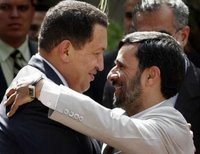
 Site feed
Site feed 

